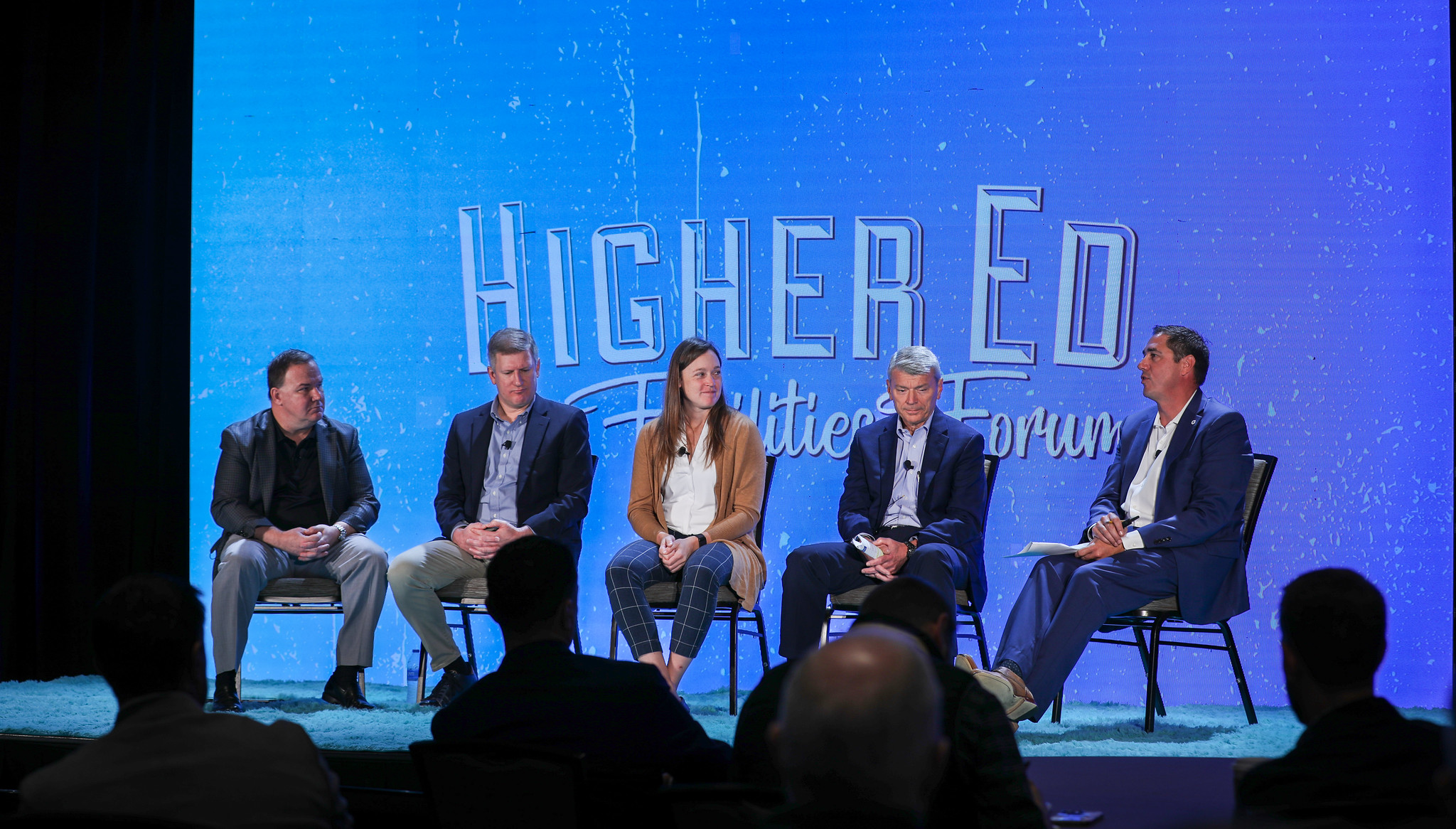
Between workforce challenges, falling tuition rates, lofty climate action goals, and the end of pandemic-era aid funding, higher education is in a period of transformation. As campus leaders chart a course into the future, few face quite so immense a challenge as facilities officers —the ones very literally tasked with building and maintaining that future.
In a recent discussion at the Higher Ed Facilities Forum, four facilities veterans gathered to discuss their own approaches to the challenges they share, from planning strategies to sustainability initiatives. Moderated by Russ Garcia, Higher Education Industry Director at Johnson Controls, the panel included Mike Chihoski, Sr. AVP, Facilities & Services at the University of Rochester; Shane Conklin, Associate Vice Chancellor, Facilities & Campus Services at UMass Amherst; Lisa James, AVP, Facilities Management at Cornell; and Doug Marsh, VP, Facilities Design & Operations and University Architect at Notre Dame.
The University of Rochester has recently adopted a new approach to master planning, under the auspices of Boundless Possibility, its 2030 Strategic Plan. As Chihoski explained, it’s not a traditional campus master plan but an institutional master plan encompassing the university’s multiple campuses as well as its off-campus buildings. In the past, administrators would put out a request for proposals, interview a few finalists, and decide who to work with for 18 months based on a one-hour interview. In the new process, they put out an RFP and brought four finalists to campus for a paid charrette.
“We wanted to see how they would work,” Chihoski said. “The reason we wanted to pay them is we wanted to make sure that they put their best effort forth, but second, we wanted to own any ideas they generated. So even though we're not gonna select three of those four, good ideas came from all four sessions and we have the ability to incorporate those ideas into our final product no matter who we select.”
While he spoke highly of the new process, he also stressed the need to balance aspirational planning with practical needs and constraints. “They had a lot of beautiful buildings that they had planned that sat in parking lots,” he said. “Well, someone's gotta tell the administration that you have to build structured parking if you’re taking that parking away. That's tenfold the cost of a surface parking lot, so that has to be built into the budget and has to be part of the plan.”
James described similar challenges in Cornell’s efforts to renew housing stock and expand its research facilities: the need to build quickly and cheaply naturally runs counter to the need to build for the long term. “We're not understanding the real investment needs for the next 50 years of a facility,” she said. “We haven't really increased our funding to support that or our headcount to deal with things.”
“We're seeing a lot of technology become obsolete very quickly,” she added. “I have 60-year-old elevators that are operating great on campus, and I'm replacing my 15-year-old ones. We did not figure out what it was gonna take to fund all of that need in a shorter amount of time.”
James’s point raised an important question: what steps can facilities teams take to ensure adequate funding for a building’s lifespan?
“We try to raise 15% more to cover a long-term renewal,” Marsh said of donor-supported buildings at Notre Dame. “Not for day-to-day R&M, but to put the money in the university's endowment—so that in 40 years when the roof needs to be replaced, or major mechanical components need to be replaced and upgraded, there's money there for it.”
At the University of Rochester, Chihoski’s team also puts together endowments for donor-supported buildings. As he marveled, however, it can be quite difficult to pin down the appropriate figure. “I'll be honest, it’s a guess as to how much money you need to put in there,” he said. “Alan McNiff, our VP of Facilities, personally took on that challenge to say, ‘I’m gonna put real costs on this.’ And it was a shock. They needed almost double the endowment they thought they needed to maintain these buildings properly over time and pay those costs.”
Recent years have seen an increasing emphasis on sustainability, with many institutions putting it front-and-center in their master planning. “It has to really be part of your core values,” Marsh argued. Notre Dame has adopted the LEED system, which he acknowledged can be costly and labor-intensive. “In the end, that third-party evaluation and accreditation helps us answer the questions that our students and our faculty and our alums are asking us,” he said. “This is still the best practice.”
The results speak for themselves. Twenty-five percent of Notre Dame’s campus has received LEED gold certification, and the certified buildings are “significantly” less energy-intensive than their counterparts. “There's some payback there from an energy utilization standpoint, certainly on carbon density and intensity,” Marsh said. “So we're really guided by that core principle.”
Of course, nothing comes easy in the facilities world. “The biggest challenge for us is funding,” Conklin said, describing various efforts his team undertook to assess the costs (“significant”) of various carbon mitigation techniques, namely geothermal heating. It’s not just the cost of the technology that poses a barrier, but also broader workforce challenges. “Because so many homes and businesses are moving to electrification, it's really hard for us to hire right now,” he explained. “We have to go out to service contractors, and sometimes their response time isn't what we would need.”
As Chihoski observed, the costs don’t let up once you transition to greener infrastructure. “You have to build your buildings right in the first place, but then you have to maintain ‘em,” he said. Building automation systems make this easier by amassing considerable data about maintenance needs, provided you have the resources to leverage it.
“We've always been able to gather data, but we haven't been able to use the data as well,” he reflected. “Today we can find a lot more problems more quickly when we see large energy losses, whether it's steam traps or other valves. You look at your utility rates and it's pretty obvious where there's a problem, and we can send people out to attack those and fix them.”

Posted by
A One of a Kind Retreat for Hotel Development, Design & Construction Leaders.
Oct 25-27, 2026 | Fort Lauderdale, FL
Learn more
© Copyright 2025 influence group. All Rights Reserved
Comments